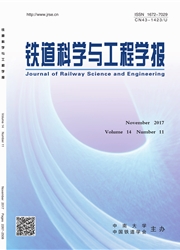

 中文摘要:
中文摘要:
A series of simulations of air flow through three kinds of2 D vegetation canopies along with different canopy morphology have been conducted by computational fluid dynamics( CFD). Two different turbulent closure models have been used, including standard k-ε turbulent model and RNG k-ε turbulent model with or without source / sink terms,respectively,for the purpose of wind energy applications. In this study,the complicated morphology of3 D vegetation canopy is simplified to three types of 2D simplified canopy model analyzed by the main parameter leaf area index( LAI). Effects of branches and leaves on airflow are also modelled by introducing circles into the 2D simplified canopy model with or without source / sink terms by adding drag force terms in the momentum and turbulent energy equations in porous sub-domains.The main model parameters of source / sink terms are identified thanks to experimental data obtained by direct wind tunnel measurements of the air flow speeds through a branch of Osmanthus fragrans. Moreover,three different canopy shapes of the vegetation canopy are introduced into the simulation. The predictive skills of single-and two-equation( k-ε) models with or without source / sink to compute profiles of mean velocity( u),turbulent kinetic energy( TKE),TKE dissipation rate( ε) and turbulent intensity( I) are compared against datasets collected from other works and field measurements. In conclusion, it is demonstrated that vegetation canopy model 1 using RNG or standard k-ε turbulent model with source / sink terms proves to be a physically accurate and numerically robust method. The method which is better than other two vegetation canopy models is recommended for future use in simulating turbulent flows within and above the canopy in 3D in more details.
 英文摘要:
英文摘要:
A series of simulations of air flow through three kinds of2 D vegetation canopies along with different canopy morphology have been conducted by computational fluid dynamics( CFD). Two different turbulent closure models have been used, including standard k-ε turbulent model and RNG k-ε turbulent model with or without source / sink terms,respectively,for the purpose of wind energy applications. In this study,the complicated morphology of3 D vegetation canopy is simplified to three types of 2D simplified canopy model analyzed by the main parameter leaf area index( LAI). Effects of branches and leaves on airflow are also modelled by introducing circles into the 2D simplified canopy model with or without source / sink terms by adding drag force terms in the momentum and turbulent energy equations in porous sub-domains.The main model parameters of source / sink terms are identified thanks to experimental data obtained by direct wind tunnel measurements of the air flow speeds through a branch of Osmanthus fragrans. Moreover,three different canopy shapes of the vegetation canopy are introduced into the simulation. The predictive skills of single-and two-equation( k-ε) models with or without source / sink to compute profiles of mean velocity( u),turbulent kinetic energy( TKE),TKE dissipation rate( ε) and turbulent intensity( I) are compared against datasets collected from other works and field measurements. In conclusion, it is demonstrated that vegetation canopy model 1 using RNG or standard k-ε turbulent model with source / sink terms proves to be a physically accurate and numerically robust method. The method which is better than other two vegetation canopy models is recommended for future use in simulating turbulent flows within and above the canopy in 3D in more details.
 同期刊论文项目
同期刊论文项目
 同项目期刊论文
同项目期刊论文
 期刊信息
期刊信息
